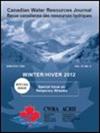气象站的空间密度对分布式和集中水文模型性能的影响
IF 0.9
4区 环境科学与生态学
Q3 WATER RESOURCES
引用次数: 5
摘要
摘要本研究旨在量化分布式和集总水文模型利用高分辨率降水和温度数据来改进流域出口流模拟的能力。为此,从一个15公里分辨率的区域气候模式模拟(来自加拿大区域气候模式- CRCM v.4.2.4,由ERA40再分析驱动)中提取了一个40年的空间分布的高分辨率气象数据集。该数据集用于提供一个分布式和四个集总水文模型。在加拿大魁北克省的192个流域上,利用5种不同气象网密度的拟站点对5个模型进行了校正。这些密度范围从单个站点(位于流域重心)到最大网格密度每225平方公里1个站点(15公里× 15公里,对应于CRCM空间分辨率)。当使用任何测试的站点密度时,两种类型的水文模型的验证性能都没有显著下降。在调查54个较小(≤2,500 km2)和84个中型(2,500 <面积<10,000 km2)流域的子集时,也得到了类似的结果。然而,对于54个较大的流域(≥10,000 km2),当使用单个站点时,分布式模型的性能下降具有统计学意义。虽然所有集总模型仅在使用单个站点时表现出明显的性能下降,但分布式模型是唯一一个随着网络密度下降而表现出性能逐渐下降的模型。这些结果表明,当处理大流域时,分布式模式可以在一定程度上受益于较大的气象网络密度。这些结论可能与加拿大流域有关,这些流域的地理特征和水文气候条件与所研究的魁北克数据库中所包括的流域相似。本文章由计算机程序翻译,如有差异,请以英文原文为准。
Impact of the spatial density of weather stations on the performance of distributed and lumped hydrological models
Abstract This study aimed to quantify the ability of distributed and lumped hydrological models to use high-resolution precipitation and temperature data to improve streamflow simulation at watershed outlets. To that end, a 40-year, high-resolution, spatially distributed, meteorological dataset was extracted from a 15-km resolution regional climate model simulation (from the Canadian Regional Climate Model – CRCM v.4.2.4 driven by ERA40 reanalysis). This dataset was used to feed one distributed and four lumped hydrological models. The five models were calibrated on 192 watersheds located in the province of Quebec (Canada) using five different meteorological network densities of pseudo-stations. These densities ranged from one single station (located at the centre of gravity of the watershed) up to the maximum grid density of 1 station per 225 km2 (15 km × 15 km which corresponds to the CRCM spatial resolution). No significant decrease in validation performance for both types of hydrological models was observed when using any of the tested station densities. Similar results were also obtained when investigating the subsets of 54 smaller (≤2,500 km2) and 84 medium-sized (2,500 < area <10,000 km2) watersheds. However, for the 54 larger watersheds (≥10,000 km2), the decrease in performance was statistically significant for the distributed model when using one single station. While all lumped models showed a noticeable drop in performance only when using a single station, the distributed model was the only model to show a gradual decrease in performance as the network density decreased. These results indicate that when dealing with large watersheds, distributed models could benefit up to some extent from a larger meteorological network density. These conclusions are likely to be relevant to Canadian watersheds with similar physiographic characteristics and hydroclimatic conditions as the ones included in the Quebec database that was studied.
求助全文
通过发布文献求助,成功后即可免费获取论文全文。
去求助
来源期刊

Canadian Water Resources Journal
WATER RESOURCES-
CiteScore
2.90
自引率
5.90%
发文量
17
审稿时长
>12 weeks
期刊介绍:
The Canadian Water Resources Journal accepts manuscripts in English or French and publishes abstracts in both official languages. Preference is given to manuscripts focusing on science and policy aspects of Canadian water management. Specifically, manuscripts should stimulate public awareness and understanding of Canada''s water resources, encourage recognition of the high priority of water as a resource, and provide new or increased knowledge on some aspect of Canada''s water.
The Canadian Water Resources Journal was first published in the fall of 1976 and it has grown in stature to be recognized as a quality and important publication in the water resources field.
 求助内容:
求助内容: 应助结果提醒方式:
应助结果提醒方式:


